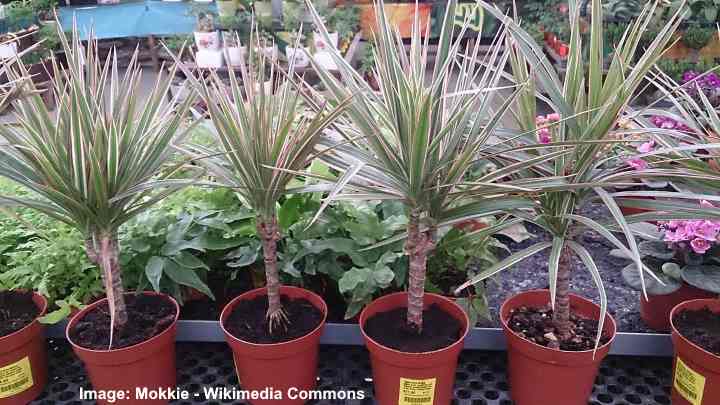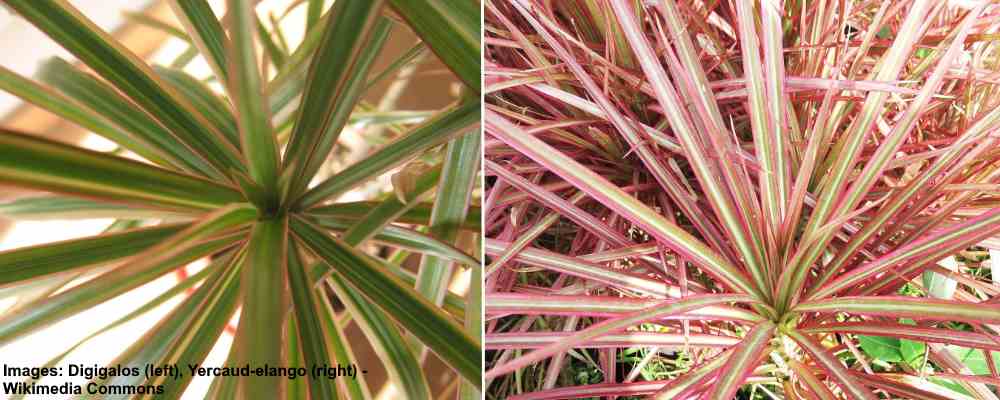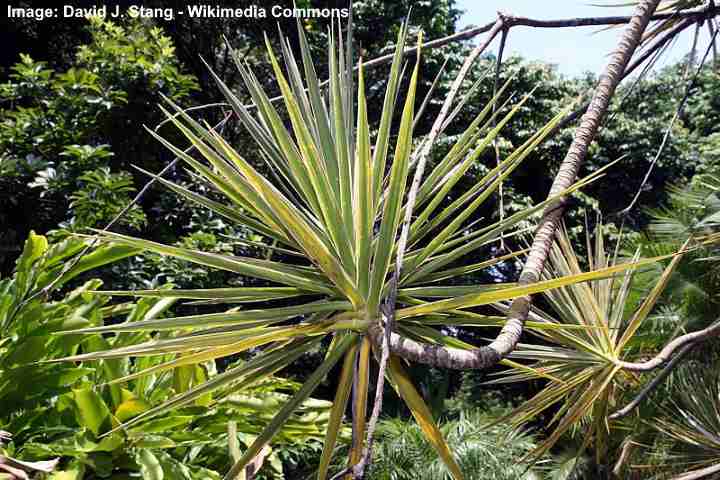The dragon tree (Dracaena marginata) is a popular houseplant that can be grown indoors in most situations. The dragon plant has a slender stem with tufts of slender, arching, sword-shaped leaves that resemble those of a tiny palm tree. The plant’s spiky look makes it an attention-grabbing indoor specimen tree, and the leaves give it a unique appearance. For homes or offices, the Madagascar dragon tree is a great potted plant.
Dracaena Marginata Plant Care – Overview
Plant Dracaena marginata in bright, indirect light and keep it in well-draining potting soil to grow it. Whenever the soil has partly dried, water the Dracaena marginata plant. The dragon plant thrives in growing temperatures of 70°F to 80°F (21°C to 26°C) and requires occasional fertilizing.
About Dracaena Marginata Plant (Red Edged Dracaena)

Dracaena marginata, sometimes known as red-edged dracaena or Madagascar dragon tree, is one of approximately 120 different species in the genus Dracaena. The dragon trees may grow up to 15 feet (4.5 meters) tall in their natural habitat of Madagascar.
The slow-growing beautiful dragon trees grow to about 3 feet (0.9 meters) when cultivated in pots indoors. Because they can handle low-light, irregular watering, and neglect, dragon trees are popular indoor plants.
The dragon plant, which is endemic to Madagascar, has a spiky crown of leaves that grow upward and arch over. The leaves are 12 to 35 inches (30 to 90 cm) long and 0.8 to 2.7 inches (2 to 7 cm) broad.
Red Edged Dracaena
The variegated leaves with crimson borders make these dragon palms stand out. Red edged dracaena is the common name for this plant because of its long, glossy, tapered leaves that are green with red edges.
Dracaena marginata cultivars with various colored leaves, such as Dracaena marginata ‘tricolor,’ have yellow bands in addition to the crimson borders, and Dracaena marginata ‘colorama’ has more prominent crimson borders that give it a more pink-violet color. You’ll discover how to take care of Madagascar dragon trees in this article.
How to Care for Dragon Tree Plant (Dracaena marginata)
The dragon plant has some fundamental growing needs, despite being one of the simplest houseplants to maintain. A Dragon Tree Plant (Dracaena marginata) can be cared for in a variety of ways.
Dragon Plant Light Needs

Indoors, in indirect light, the dragon tree thrives. Indirect sunlight is sufficient for the indoors tree to thrive. The glossier green and scarlet leaves stay glossy and healthy thanks to the right quantity of light. Sunburn on the leaves can be caused by direct sunlight. The dragon plant is a kind of plant that can survive without much sun, despite its preference for bright light.
Therefore, in a shaded location or a room that receives little natural light, you may put the Dracaena marginata plant pot. These plants are wonderful bathroom plants because they favor moist environments.
It’s important to keep in mind that low-light situations will limit its development. The plant may not seem to grow much in a dark room or at work, and the leaves may be smaller. Of course, this slow growth rate can be beneficial for indoor plants if you have the dragon tree on your desk or shelf.
Water Requirements for Dragon Tree Plant

When the top soil dries out, thoroughly water your dragon tree houseplant. Let the plant soak in water until it drains out of the pot. When the soil has partly dried out, water a dragon plant (Dracaena marginata). To determine if the soil is dry, put your finger about 1″ to 2″ (2.5 cm) into it. You know it’s time to water the plant when the potting mix is dry. Water it every 7 to 10 days during the summer.
Dracaena marginata should not be watered too frequently. Root rot and a variety of bacterial or fungal problems are caused by overwatering. Your lovely dragon plant may begin to droop, lose leaves, and die if the soil is constantly waterlogged. You may have to water it less and need to repot it if you want to revive a dying Madagascar dragon tree with soggy soil.
Watering houseplants—particularly dragon plants—is easiest when the soil is thoroughly drenched and allowed to drain. The roots are well nourished and hydrated when this degree of deep watering is used. When 2 inches (5 centimeters) of top soil is completely dry, you should water the plant again.
Frequent, shallow watering is one of the watering mistakes to avoid. Moisture can’t get to the roots because watering isn’t frequent enough. Instead, around the stems, you cause water to build up in the upper layer of the soil. White mold develops in this environment, and fungus gnats thrive.
Only water a dragon tree when the top level of the earth dries out on a regular basis. Dragon plants are drought-tolerant and can go a few weeks without water.
Best Soil for Dragon Tree

Dracaena marginata plants need a good drainage potting soil and vary in color of their leaves. A combination of loamy soil and peat moss is the ideal potting medium for the dragon plant. To improve soil drainage, add perlite. Grow the indoor tree in a container with drainage holes to ensure that the soil drains properly.
For Dracaena marginata plants, you may prepare a proper potting soil. One-part bark chips, one-part peat, and one-part perlite are all combined. The organic material retains moisture, and the bark chips offer nutrients and drainage, making this combination of nutrients ideal for dragon trees.
There are a few ways to check if your potting soil is suitable for dragon plants. When watering, the water should drain quickly. Second, in the summer, you should water the plant once a week or so because it should contain enough moisture. Water shouldn’t collect on top of the soil in the third place.
The Right Indoor Temperature for Madagascar Dragon Tree Plant

Grow your Dracaena marginata plant in a regular environment to take care of it properly. The ideal temperature for healthy growth is between 70°F and 80°F (21°C and 26°C) in the interior. Direct sunlight, hot radiators, and cold drafts should all be avoided with dragon plants. Dragon plants are able to survive in lower temperatures because they are simple to look after.
They can still flourish in rooms that are between 65°F and 70°F (18°C and 21°C), provided they’re not too hot. If temperatures below 50°F (10°C) are common, the plant could begin to die. Your dragon tree will thrive most often if you feel at ease in your growing environment.
It’s important to keep your lovely indoor trees safe from temperature extremes throughout the summer and winter. Keep the plant pot away from air currents and cold air from an air-conditioning system throughout the summer. Don’t put the dragon plant near a hot radiator in the winter.
During these seasons, you’ll want to remember to water more often in the summer and less often in the winter.
Humidity Levels for Growing Dragon Tree Plant Indoors

When grown as houseplants, dragon tree plants prefer moderate humidity levels. Dragon plants can typically grow in low humidity levels in the home. You might mist the tree’s leaves weekly if your home has particularly dry air. Instead, you could use a humidifying pebble tray to hold the Dracaena marginata houseplant pot.
Cleaning the leaves of your dragon tree with a wet cloth is one way to care for it well. Wiping the leaves down cleans dust off of them as well as moisturizing them. This helps with photosynthesis, which is helpful for keeping the sword-shaped leaves lush and glossy.
How to Fertilize Madagascar Dragon Plant

During the spring and summer, fertilize your Dracaena marginata plant once a month. A regular, balanced houseplant fertilizer diluted to half-strength is another option. Throughout the growing season, feed the dragon plant once a month, starting in spring and ending in early fall. Don’t fertilize in the fall or winter. Don’t over-fertilize a thriving dragon tree plant at home. Too much fertilizer may cause your plant to wilt and die as a result of being overwatered.
You may flush the soil once or twice throughout the growing season to support your plant’s growth. When minerals don’t rinse from the soil as readily as they do when growing outdoors, this technique is beneficial for indoor plants. Just take your potted dragon plant to the bath or outdoors for all of the cleaning you need. For two to three minutes, slowly run water through the soil. Before returning the plant to a bright location, allow it to drain completely.
Pruning Dragon Tree Plant

Pruning a Madagascar dragon plant helps to maintain its height and encourage bushy development, as seen in the photograph. Stems may develop into long and naked after a while. Stop cutting the stem where you want new branches to grow if this occurs. New stems develop beneath the cut after you prune. To remove dead leaves and polish the dragon tree’s look, you may also prune it.
How to Propagate Dragon Plant
Rooting stem cuttings are simple to grow Dracaena marginata plants. Cut off a leafy section of stem with a clean sharp knife or pruning shears. You should make sure that the cutting has at least two nodes. For the roots to grow, put the cutting in a jar of water. You may move the stem cuttings to a new pot after they’ve been rooted. You can grow two or three cuttings in one pot to create a bushy Dracaena tree.
Repotting Madagascar Dragon Tree

Since they only need to be repotted every two or three years, dracaena marginata plants are a great choice for beginners. Even in ideal conditions, most Dracaena varieties take a long time to grow. Annual repotting is not required since palm-like houseplants prefer to be rootbound.
Select a new container that is 2″ (5 cm) larger than the current one when it comes time to repot your dragon tree. The roots have more space to develop and flourish in a bigger container. Repotting your dragon tree is simple:
- Pull on the stem to carefully remove the plant and root ball.
- Inspect the roots for any damage, such as mushy brown roots, before shaking off the excess dirt. Trim to the appropriate level.
- Fill a new container with half-full light potting soil.
- Fill the remaining space with additional soil when you put the tree in the pot.
- Water your plant thoroughly and gently press around the stem to give it support.
- Place it in a spot that gets some shade.
You may use the aforementioned instructions if you simply want to refresh the potting mixture and keep the plant at a similar height. Repot it in the same pot instead of a bigger vessel, if you choose. To make room in the pot, you’ll want to cut roughly a third of the root length.
Pests Affecting Dragon Tree Plants

Your indoor Madagascar dragon tree may grow to be 15 feet (4.5 meters) tall if cultivated outdoors. These little pests may harm your plant if they are not treated, and it will perish as a result. Mealybugs, scale, thrips, and spider mites are the most prevalent infestations attacking dragon tree plants.
Here’s how to detect houseplant pests signs in a variety of ways:
- Scale—On the plant’s stem, look for unusual brown bumps.
- Mealybugs—Fluffy cotton-like specks that are discovered beneath leaves or on stems are the pests’ outward appearance.
- Thrips—Inspect for tiny, slender insects hiding beneath foliage. They’re usually black, although they might be white, green, or brown.
- Spider mites—Webbing beneath leaves or around stems is a common symptom of spider mites. When the soil and room air are extremely dry, these pests appear.
Madagascar Dragon Tree Diseases

Dracaena marginata is a tough houseplant that is disease-resistant and grows in the wild. Leaf spot disease is the most common kind of fungus that affects dragon plants. Leaf spot occurs as brown patches on glossy green leaves when overwatering occurs. Leaf drop or wilting stems may also be caused by too much water.
Stop watering the plant until half of the potting soil dries out as the best way to get rid of plant diseases. It may be required to repot your plant in a fresh, sterile potting mixture if it does not revive. Remember to cut off any infected roots while inspecting the roots.
Is the Madagascar Dragon Tree Plant Poisonous?
Cats and dogs should not be exposed to the Dracaena marginata. Saponins, according to the American Society for the Prevention of Cruelty to Animals (ASPCA), are toxic in Dracaena plants. Vomiting, anorexia, drooling, and dilated pupils in cats are all symptoms of pet poisoning.
Is a Dracaena marginata a Palm tree?

The dragon tree is not a genuine palm, as the spiky variegated leaves resemble. This is why this Dracaena plant is known as the “dragon palm,” since it looks a lot like indoor palms such as areca palms or saw palmetto.
Do Dragon Trees Clean the Air?
toxins from the home air may be removed by plants in the Dracaena genus, such as dragon trees. Dracaena marginata may help to reduce indoor air pollutants, according to NASA scientists’ research. Formaldehyde, benzene, and trichloroethylene were among the chemicals mentioned.
Common Care Issues with Growing Dragon Tree Plant

Madagascar dragon trees are toughy houseplants that require little care. However, you may still notice some problems that influence their development, despite your best efforts.
Why a Dragon Tree has Brown Leaf Tips?
Moisture or temperature problems are most common brown tips on the leaves of Dracaena marginata. When the earth is partially dry, make sure to water the dragon plant. Make sure that the plant isn’t being affected by drafts. To help the plant recover, give it a light watering.
Why a Dragon Tree has Brown Spots on Leaves?
If brown spots appear on the leaves of your dragon plant, check to see if you’re watering enough. This might be caused by dry soil. The bottom portion of the potting soil should always be damp.
Why Dragon Tree Leaves Start Yellowing?
Your dragon plant’s ancient leaves are destined to yellow and fall, as is natural. Check the soil for moisture if many leaves are yellow. Overwatering your indoor plant may cause its leaves to yellow. Waiting until the upper section of the soil has dried is a good strategy for avoiding watering.
Why Dragon Tree Leaves are Falling Off?
Some leaf drop is normal for the dragon tree, even though it is an evergreen houseplant. Leaves can wither and fall off if there is too much water or if the lighting is poor.
Why Dragon Tree has Soft, Soggy Stems?
Soggy stems are one of the most classic symptoms of overwatering your dragon plant. Only water when the soil dries and do not waters the Dracaena marginata plant too often in the winter. This could imply that you need to water your plant every few weeks or even less.
